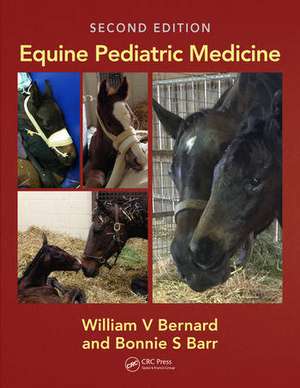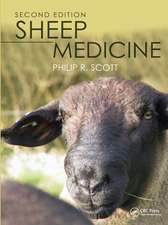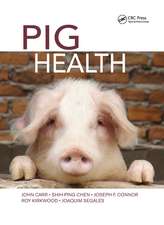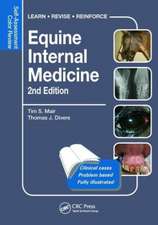Equine Pediatric Medicine
Autor William V. Bernarden Limba Engleză Hardback – 13 iul 2018
This systematic yet concise guide to equine pediatric medicine covers etiology, pathophysiology, clinical presentation, differential diagnosis, diagnosis, and management. Beginning with a thorough explanation of the physical examination, the chapters then take the reader through the different disorders associated with each body system, including liver, cardiovascular, respiratory, opthalmologic, endocrine, and muscoskeletal diseases. A brand new chapter on nurtition has been added to this fully revised text.
The book is superbly illustrated throughout with photographs, diagrams, radiographs and tables, while a new section of in-depth case studies brings the information to life. Equine practitioners will value this as a ready reference, while veterinary students and technicians can use it as a complete guide to equine pediatric disease.
Preț: 1039.10 lei
Preț vechi: 1259.06 lei
-17% Nou
198.83€ • 208.15$ • 164.52£
Carte tipărită la comandă
Livrare economică 05-19 aprilie
Specificații
ISBN-10: 1498776000
Pagini: 350
Ilustrații: 479 Illustrations, color
Dimensiuni: 210 x 280 x 20 mm
Greutate: 0.98 kg
Ediția:2 New edition
Editura: CRC Press
Colecția CRC Press
Public țintă
Professional Practice & DevelopmentCuprins
Notă biografică
Dr. Barr earned her veterinary degree at the University of Pennsylvania. She then completed a one-year internship at Rood and Riddle Equine Hospital and a two-year internal medicine residency at the University of Pennsylvania’s New Bolton Center. Dr. Barr was a staff member for one year at Texas A&M University before rejoining Rood and Riddle Equine Hospital in 2001 as an associate veterinarian specializing in internal medicine. She became boarded in internal medicine in 2003 and in 2014 a shareholder at the practice. Her areas of special interest include equine neonatology, equine infectious diseases and infectious disease control. Dr Barr is the co-author of Equine Pediatrics and has published articles in numerous veterinary journals and textbooks.
Recenzii
The book is most appropriate to the clinically taught years of vet school, but I also believe that it’s a good book to have (at least knowledge of its existence!) if attending a stud on a pre-clinical-years placement (AHEMS). I personally would have found the resuscitation chapter and the introductory information very useful during my stud placement in 2nd year. It offers a good, broad knowledge and coverage of all body systems, organised into such which makes it really easy to orientate through. I feel like it goes into a lot of detail within each of the sections too. There isn’t one chapter that lacks detail compared to the others. I also like how it gives a range of treatment options for each of the conditions, acknowledging author preference but also stating why that may not always be an option. The only suggestion I have to improve this part would be to make reference to the costs of treatments (not specific numbers, but which is cheapest/ most expensive and reference to which is most useful- means vets can weigh up treatment options).
Admittedly, I already have a very keen interest in the subject, but I found it very useful and readable. I picked it up day after day to read with excitement. Sometimes the odd sentence can be a little long and therefore at times hard to make sense of, but generally I really enjoyed the layout and flow of the text. The chapters followed each other well. W
Descriere
This systematic yet concise guide to equine pediatric medicine covers etiology, pathophysiology, clinical presentation, differential diagnosis, diagnosis, and management. Beginning with a thorough explanation of the physical examination, the chapters then take the reader through the different disorders associated with each body system, including liver, cardiovascular, respiratory, opthalmologic, endocrine, and muscoskeletal diseases. A brand new chapter on nurtition has been added to this fully revised text.
The book is superbly illustrated throughout with photographs, diagrams, radiographs and tables, while a new section of in-depth case studies brings the information to life. Equine practitioners will value this as a ready reference, while veterinary students and technicians can use it as a complete guide to equine pediatric disease.










